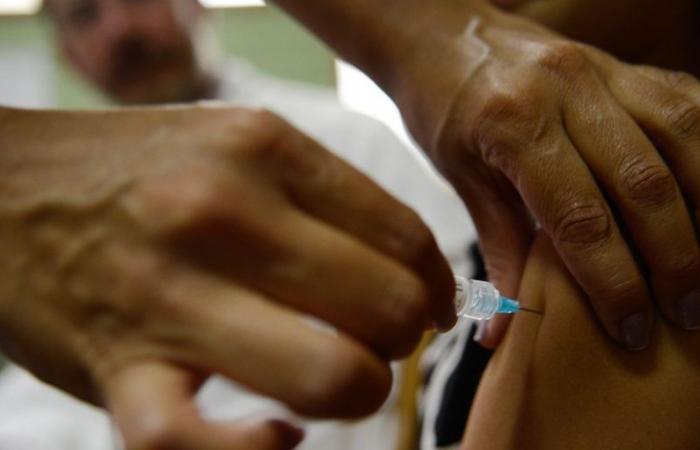Vaccination against the human papillomavirus, HPV, in the Unified Health System (SUS) will no longer be carried out in two doses and will become a single dose. The change will come into effect following the publication of a technical note, later this Tuesday (2).
“As of publication, people who received one dose are already fully vaccinated and will not need to receive the second”, reinforced the director of the National Immunization Program at the Ministry of Health, Eder Gatti.
The vaccine used in the new public network scheme remains the quadrivalent dose produced by the Butantan Institute, which protects against four subtypes of HPV associated with cervical cancer.
In an interview with Brazil Agencythe president of the Brazilian Society of Immunizations (SBIm), Mônica Levi, considered the change a wise strategy.
“It’s a trend. Several countries around the world are switching to a single dose. Some because they don’t have a vaccine and the only way to introduce it is with just one dose. Others, such as Australia, Scotland and Denmark, switched to the single dose because they have already managed to control or reduce the circulation of the virus, lesions and cancer itself by more than 90%. So, they are moving to a dose to keep the virus circulating low or even absent.”
“This scenario depends on vaccination coverage and not on the number of doses. If you have low vaccination coverage, even with two doses, you will not be more successful than when there are a lot of people vaccinated – even with just one dose”, he explained.
Mônica also highlighted that the change applies strictly to the SUS and that the two-dose schedule for adolescents aged 9 to 14 is maintained in the private network. This is because, according to her, studies indicate the effectiveness of a single dose against HPV in preventing cervical cancer, but the virus is associated with other types of cancer, such as the oropharynx, penis, anus, vagina and vulva.
“Brazil is a signatory to a World Health Organization agreement to eliminate cervical cancer and take all necessary measures by 2030. These measures include vaccination, adequate screening with at least two tests throughout women’s lives and access to treatment. Today, Brazil is focused on eliminating cervical cancer. Now, those who get vaccinated in the private system also want protection against genital warts and other types of cancer. And we don’t have this data with a single dose because it hasn’t been studied. That doesn’t mean it won’t work, but we don’t have that data.”
Check out the main excerpts from the interview:


President of SBIm Mônica Levi spoke with Agência Brasil – Sarah Daltri/SBIm/Disclosure
Brazil Agency: How does the Brazilian Society of Immunizations (SBIm) evaluate the ministry’s decision? Do you believe that it was taken at the right time, considering the current Brazilian scenario of low HPV vaccination coverage?
Monica Levi: I consider it to be positive for Brazil. We really had low coverage, low adherence for the second dose. With just one dose, we will be able to increase vaccination coverage. It’s easier, right? Logistics become easier. And what we have data on is that, if you have great coverage with one dose, perhaps you will get a greater benefit than with two doses for fewer people. This is what we are seeing happening in the world. For a period of eight to 10 years, we have data from studies showing that protection is similar with one, two or three doses.
Scotland is an example. We saw that there, those who were vaccinated at the age of 12 or 13 – with one, two or three doses – had practically no cervical lesions. And this has been since 2007, when Scotland began vaccinations. So, their analysis today is that, regardless of the number of doses, the benefit was the same. This is a reason to have greater equity in vaccination in the world. The big benefit that I see is that those who are currently between 15 and 19 years old and missed the opportunity – mainly due to the pandemic – and are no longer at the age of the target audience for vaccination will also have the chance to get vaccinated and get vaccinated. protect.
Brazil Agency: Adolescents who have already taken a dose would, until now, have an incomplete vaccination schedule. After the publication of the technical note, do they automatically no longer need the second dose? How are these cases?
Monica Levi: This is a message that we have to be careful about sending because medical societies will not migrate to the single dose. The Brazilian Society of Immunizations and the Brazilian Federation of Gynecology and Obstetrics will maintain the two-dose schedule for up to 20 years of age and three doses for those over 20 years of age. It becomes an individual concern. Those who get vaccinated want protection against everything that the vaccine can protect against. Brazil is a signatory to a World Health Organization (WHO) agreement to eliminate cervical cancer and take all necessary measures by 2030. These measures include vaccination, adequate screening with at least two tests throughout life of women and access to treatment. Today, Brazil is focused on eliminating cervical cancer. Now, those who get vaccinated on the private network also want protection against genital warts and other types of cancer. And we don’t have this data with a single dose because it hasn’t been studied. That doesn’t mean it won’t work, but we don’t have that data.
Brazil Agency: The ministry also asked states and municipalities to actively search for young people up to 19 years old, men and women, who have not yet received any dose against HPV. Why an active search in this group? Is there any possibility of expanding the current target audience?
Monica Levi: It doesn’t mean we’re going to vaccinate against HPV [o público] from 9 years old to 19 years old as a routine, forever. There will be a period, perhaps from six months to a year, in which a catch-up, which is to seek out all those who should have received the vaccination between the ages of 9 and 14 and, due to the pandemic or for any other reason, did not receive it and are now no longer old enough to be vaccinated through the SUS. So, these boys and girls who are between 15 and 19 years old will be vaccinated, but reinforcing: in a period of catch-up. It is not a routine vaccination forever.
It’s a very positive thing. If we have a large adherence, we will have a greater benefit in terms of moving towards the elimination of cervical cancer. The vaccine is important for boys and girls, as there are also diseases associated with HPV in males. The focus of this ministry’s decision for a single dose is the elimination of cervical cancer and many countries are doing the same thing. The WHO recommends this and we hope to protect more people. The outcomes will probably be better than maintaining two doses only for 9 to 14 years old and not getting vaccination coverage for the second, which is what is happening.
Brazil Agency: How was HPV vaccination coverage in Brazil so far, with the two-dose schedule?
Among boys, only 27% have the second dose. This has been happening since 2017 – coverage accumulated until 2023. Among girls, 56% have had the second dose, according to data from the National Cancer Institute (Inca). If we now concentrate on efforts to increase vaccination coverage in a single dose, and carry out coordinated campaign work, I think we can have a better result in the long term. Better than maintaining two doses with low coverage and skating on this, in addition to leaving adults or older adolescents without protection against HPV.
Brazil Agency: Based on the experience of other countries, is it possible to think of a window of time so that we can talk about eliminating cervical cancer in Brazil?
Monica Levi: The elimination of cervical cancer occurs when you reach a percentage of four or fewer cases for every 100,000 women. Some countries have already been moving towards this scenario since 2022, such as Sweden, Australia and Denmark. Australia has six cases for every 100,000 women, very close to elimination.
Eliminating cervical cancer is not reaching zero, but transforming the disease into a rare pathology. There will be escape cases, of course there will be. But very little. It goes from being one of the cancers that kill the most women in the world to becoming a rare cancer. This is the idea. That’s what elimination is. And, in Brazil, we still have between 13 and 16 cases of cervical cancer per 100,000 women. There are 17 thousand new cases and 6.6 thousand deaths every year.
Tags: Understand HPV vaccination Brazil
--







